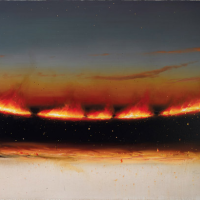33. TIM STORRIER

Evening Fire Line is a quintessential example from Tim Storriers oeuvre: grand in scale, balanced in composition, and poignant in subject matter. The idea to paint burning rope under the night sky was born one evening on an outback trip in 1981. Struck by sudden inspiration, the 32-year-old Storrier jammed steel posts into the arid dirt, tied a rope between them and set it alight, and with it sparked the rest of his career. Storrier insists he cannot recall why he decided to do it or where the concept came from.1 These mysterious origins are a reminder of the highly personal nature of the process of making art.
The process of viewing art, however, stirs different memories and builds different meanings for each individual. For example, Storrier was once having lunch in the Savage Club in Melbourne with a number of artists including Sir William Dargie (1912-2003), in his nineties at the time. Dargie told Storrier that his fire line paintings were reminiscent of Indigenous burnings as viewed from a steamboat from Melbourne to Sydney: when I used to take the steamer to Sydney I would look towards shore and, in those days, the Indigenous people were still burning off the vegetation its called fire gardening these days You could see these lines of fire around the shore.'2 It is perhaps this link to the regeneration of the bush, along with the distinctively flat outback setting, that gives Storriers fire line works a curious resonance for Australians.
Storrier is known for heroing the vast Australian sky in his works, often producing a composition with a low horizon and a star-filled sky dominating three-quarters of the canvas. Evening Fire Line is an example of the artist focusing more on the object than the landscape by utilising a real rope and centring it in his composition, the third dimension of the rope further drawing the attention of the viewer. The rich impasto paint covering the rope, with spots of pure white, give it a realistic heat and dynamism, contrasted by the flat, still sky behind. Despite this emphasis on the rope, the sky remains a significant and perfectly executed component of the work, as in all of Storriers landscapes. The orange of the sunset enhanced by the fires glow, subtly fades into pale then deep blue. The same way a photograph of a sunset does not do it justice, the printed reproduction of the sky in Evening Fire Line cannot capture the delicacy and vitality of Storriers precise blending of colours.
There has always been a strong tradition of landscape painting throughout Australian art history. In 2013 when the Royal Academy of the Arts in London presented their exhibition, Australia, the subheading explained, the story of Australia is inextricably linked to its landscape, providing a rich seam of inspiration for Australian artists for centuries.'3 Storrier is one of the few late twentieth-century artists to explore the landscape in such detail, as the genre was dominated in the first half of the century by Australian artistic heavyweights such as Arthur Streeton (1867-1943), Tom Roberts (1856-1931), Arthur Boyd (1920-1999) and Sidney Nolan (1917-1992). He brought the tradition into a contemporary context, stepping out from their shadows by creating his own unique visual language of evening skies and vertical lines of fire. These are now iconic images in our nations contemporary visual culture, having successfully carved a place for Storrier in the longstanding tradition of Australian landscape painting.
Footnotes
1. Lumby, C., Tim Storrier: The Art of the Outsider, Craftsman House, Sydney, 2000, p.45
2. Capon, E., Wright, W., Zimmer, J., and McGregor, K., Tim Storrier Moments: In Response to Memories and Ideas of Mortality, Macmillan Art Publishing, Melbourne, 2009, p.69
3. Royal Academy of the Arts, https://www.royalacademy.org.uk/exhibition/australia, accessed 29/05/2020
Asta Cameron BA, MA (Art Curatorship)